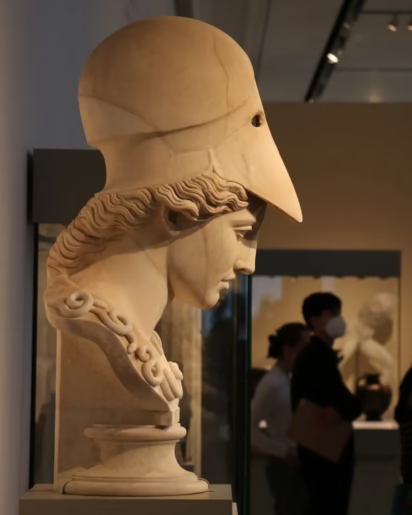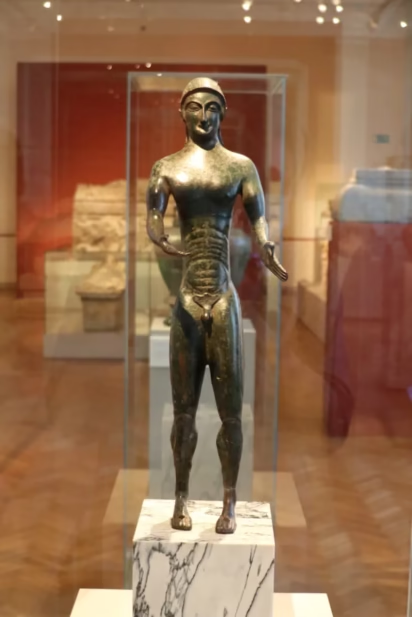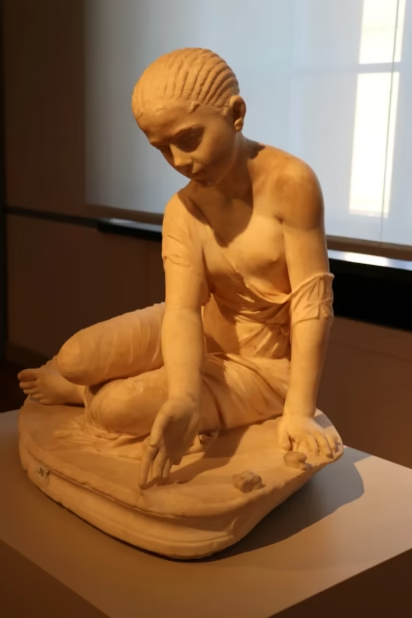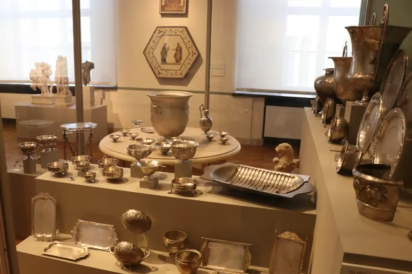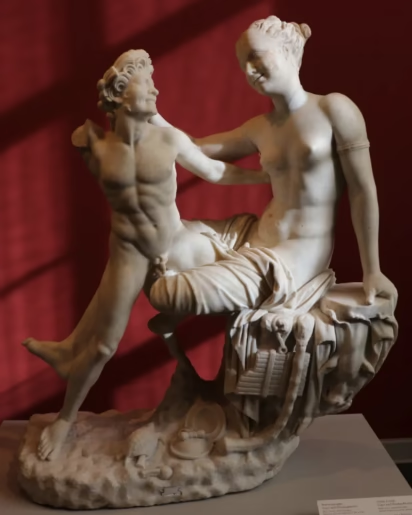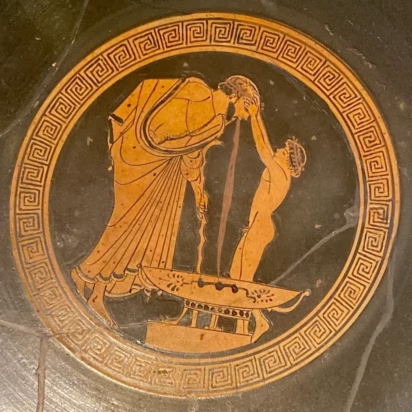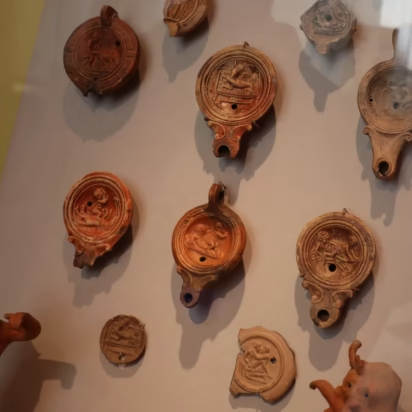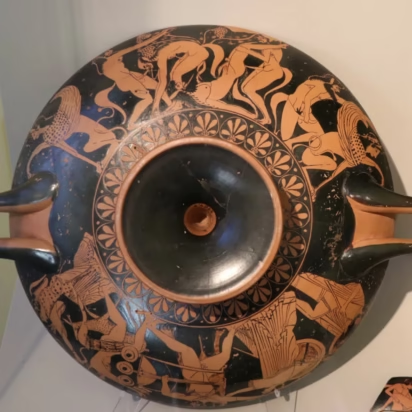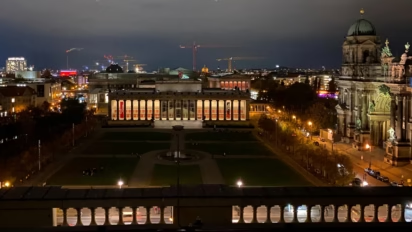Visit the Altes Museum in Berlin to see classical antiquities with an emphasis on Greek, Etruscan, and Roman art.

The Altes Museum on Museumsinsel in the heart of Berlin is used to display high art from classical antiquity. The main reason to visit is to see the magnificent Greek art collection that includes sculptures, vases, pottery, monuments, decorative items, and jewelry. A further highlight is the Etruscan collection, considered the largest outside Italy. The Roman sculptures are often copies of Greek originals while the funerary monuments are particularly impressive. The Altes Museum also has a notable erotica collection. Buy skip-the-line tickets online and proceed directly to the gallery entry door. From mid-April 2024, the museum is closed on both Mondays and Tuesdays.
Visit Exhibitions in the Altes Museum in Berlin
The Altes Museum on Museums Island in Berlin is home to part of the Collection of Classic Antiquities of the Staatliche Museen zu Berlin (SMB). Items on display here include Greek, Etruscan, and Roman art from around 1000 BC to AD 300.
The antiquities in the Altes Museum are mostly sculptures, vases, objects used in daily life, jewelry, and coins. Further items from the Antikensammlung are on display in the Pergamon Museum and the Neues Museum. (The famous Greek Pergamon Altar will only be on view again from around 2027 but many of its statues are displayed temporarily in the Pergamonmuseum Das Panorama.)
Greek Art in the Altes Museum Berlin

The main floor of the Altes Museum in Berlin is used for the display of Greek art. The exhibitions in the twelve halls start with the heroes of early Greece (from 1000 BC onwards) and follow a variety of themes until the Romans became the dominant force in southern Europe during the first century BC.
Major themes are as could be expected Greek gods and heroes, the symposium and athletics, life and death, coins, and jewelry.
An impressive number of statues are on display. Some are in a very well-preserved condition while others were restored throughout the centuries — this was often done centuries ago in a way that would not occur currently. In some cases, alterations were already made in antiquity, or heads and bodies might be from the same period but only united much later.
Greek Pottery and Stoneware in the Altes Museum

The large collection of vases and decorated pottery covers all themes and eras. Popular decorations include Greek sagas and myths, e.g. the tasks of Heracles, scenes from the Iliad and the Odyssey, or preparations for athletic events.
Two artistic highlights from circa 500 BC are:
- The portrayal of Achilles dressing the wounds of Patroclus in a kylix signed by the potter Sosias — it shows the two Greek heroes in a very unheroic and humanist pose.
- An amphora of Satyrs with musical instruments and Hermes on the way to a symposium by the “Berlin Painter”.
With so many complete, if repaired or restored, vases available, it is worth paying particular attention to the odd solo fragments — one for example have warriors emerging from the wooden horse in Troy.
Coins and Jewels in the Altes Museum
It is easy to miss the coin collection (room 4) and the ancient jewelry collection (room 8), which are both in smaller rooms off the main visitor’s route. (More are also in the main display halls.)
The Münzkabinett (numismatic collection, or directly translated more descriptively as the coin cabinet) owns over half a million coins including 102,000 from Greek antiquity and 50,000 Roman — only around 1,400 are displayed in the Altes Museum (many more in the Bode Museum). Note the blue ceiling — it is the only room in the museum where the original Schinkel ceiling was restored.
Greek Antiquity Highlights in the Altes Museum in Berlin
Some of the highlights in the Hellenic section of the Altes Museum include:
Berliner Göttin — the so-called Berlin Goddess has been downgraded in modern times to a funeral statue of a woman for a rich family grave. This marble sculpture from Keratea (Attica in Greece) dates from 580 – 560 BC and is famous for its magnificent red garment.
Rotunde — the rotunda was an absolute architectural highlight of the museum when it opened. It was obviously inspired by the Pantheon in Rome and is the only part of the interior of the building rebuilt similar to the original when the museum was reconstructed in the mid-1960s. Various statues are on display between the 20 Corinthian columns. Most of these sculptures are heavily restored — information sheets explain the portrayals and restoration — but are still impressive to see.
Betender Knabe / Praying Boy — this Greek bronze nude is one of the most popular works in the Altes Museum. The arms are new but the rest of the statue of a naked young man dates from around 300 BC from Rhodes (Greece). He welcomes visitors entering from the rotunda in the position Schinkel originally planned for him when the museum was designed almost two centuries ago.
Although most of the sculptures are male — women played a very subdued role in Greek public society — several of the highlights are of women and female goddesses. The Goddess of Taranto on her throne, Magna Gaecia, 475–450 BC, is exceptionally well preserved despite missing both hands. The displayed Wounded Amazon still has both breasts on this Roman copy of a lost Greek original by Polykleitos (ca. 430 BC).
Etruscan Art in the Altes Museum
The upper floor of the Altes Museum is used for Etruscan and Roman art. The Etruscan collection, one of the largest outside Italy, is particularly praised. It includes amongst other sculptures, pottery, jewelry, mirrors, and architectural details.
The prominently displayed statuette of an Etruscan warrior (cast bronze, 5th century BC) and a figurine of a naked youth (bronze, around 500 BC) are quite different in style from the Greek works on the main floor.
Roman Art in the Altes Museum
Roman themes in the Altes Museum in Berlin include life and death with several sarcophagi and a large collection and variety of funeral monuments and sculptures. The Girl Playing Astragaloi (around 150 AD, head 200 AD, Knöchelspielerin) is an adaptation of a popular Hellenistic model but the knucklebone (astragalus) game was added by the Romans, as was often used on funeral monuments. Some of the sad-faced child busts are particularly moving — the Romans certainly did funerals and death memorials well.

The audio guide reveals the whole sorry saga portrayed on the Medea Sarcophagus — a complete tragedy with love, jealousy, betrayal, conspiracy, several murders most foul, and revenge depicted on a single sarcophagus side in Rome (marble, 140 – 150 AD).
Roman Sculptures in the Greek Style

Many of the Roman sculptures are copies or adaptations of older Greek works. Many of the sculptures on display were repaired or altered throughout the centuries — sometimes already in antiquity but often too in the 18th and 19th centuries when sculptures were commonly repaired and altered in a way works from antiquity generally would not be restored by major museums today. Already in late antiquity, male genitals were knocked off to reuse sculptures in the more restrictive Christian milieu, or new heads were added to existing sculptures.
As with the Berlin Goddess, the Statue of a Boy — Possibly of Apollo has been reevaluated in modern times. Its descriptions changed from a highly valued Greek bronze from 400 BC to a still impressive but more mainstream Roman bronze from around 20 BC.
Luxury Lifestyles of the Roman Elite
Luxuries from the Roman villa illustrate the lives of the upper classes. In addition to the usual collection of utensils, home decorations, mosaics, and smaller sculptures, this section also includes the huge Hildesheimer Silberschatz. This silver treasure was discovered in 1868 in Hildesheim in Lower Saxony — a city more famous for its UNESCO-listed Romanesque churches and half-timbered houses. This find consisted of 70 silver and partly gold-gilt Roman serving dishes and is one of the largest and highest quality treasures from antiquity ever found. How it came to Hildesheim, which was far from Roman-occupied Germany, remains a mystery.
The main exhibition concludes with a large collection of busts of the Roman elite, especially emperors and Julio-Claudian princes. Several statues of Antinous, Emperor Hadrian’s young beloved, are on display in the museum. His depiction with short curly hair became the preferred style for youth portraits of the imperial family from Marcus Aurelius to Caracalla.
Roman and Greek Erotica in the Altes Museum in Berlin

Off hall 5 is the smaller Garden of Delights (room 6) dedicated to the art of love in antiquity (erotica, or smut if the items were not that old, although the artistic quality of several items is very high). This display includes a lot of male genitalia — symbol of fertility and protector against all kinds of evil in many regions — used in the shape of bells, charms, and oil lamps.
Many of the depictions are of characters such as satyrs and maenads associated with the Greek / Roman gods of love and sexuality: Aphrodite / Venus and Dionysus / Bacchus. Even in more mainstream art and especially sculptures, satyrs are often allowed sexual behavior not acceptable in the portrayal of mere human mortals.
Some of the works with the highest artistic merit even made it into the main exhibitions of the museum itself. In the main Greek display is a vase with a satyr becoming sexually aroused as a result of playing the double flute aulos. The display on the symposium also has the crude if highly artistic portrayal of a man vomiting after a good night out and the prostitute Hetaera urinating.
While studying the erotic art, note the museum description: “However, to make deductions from the image to the respective use would be missing the point… As far as the various positions of making love on the round fields are concerned, it has to remain open if they really reflect literary treatises on the subject.”
More photos at Erotica in the Altes Museum in Berlin.
The National Museum of Archaeology in Naples also has a very famous Secret Room (Gabinetto Segreto) of erotica from antiquity, while the most famous work from antiquity in Germany is arguably the manspreading Barberini Faun (Drunken Satyr) in the magnificent Glyptothek in Munich.
Altes Museum in Berlin Visitor’s Information

Opening Hours of the Altes Museum in Berlin
From mid-April 2024, the opening hours of the Altes Museum in Berlin are Wednesday to Friday from 10:00 to 17:00 and Saturday and Sunday from 10:00 to 18:00. The Altes Museum is now closed on both Monday and Tuesday.
Buying Tickets for the Altes Museum
Admission tickets for the Altes Museum are €12. Admission is free for under 18-year-olds and currently for all on the first Sunday of the month.
Buy Altes Museum skip-the-line tickets online in advance to pick up the free audio guide and proceed directly to the galleries without passing by the ticket desk. Time-slot reservations are not currently possible.
Visitors using the excellent value Berlin Museum Pass, a Museum Island Ticket, or a Berlin Welcome Card Museum Island may also enter the Alte Museum directly.
Audio guides in English (or German) are free — pick up near the ticket desk before entering the museum. The audio guide is well worth using — although descriptions in the museum are in German and English, the guide explains some of the major works in more detail.
Location of the Altes Museum in Berlin
The Neo-Classical Altes Museum designed by Karl Friedrich Schinkel and opened in 1830 is on Berlin’s Museumsinsel closing off the northern end of the former Lustgarten (pleasure garden) with the Berliner Dom (cathedral) on the eastern end and the Berliner Schloss (Humboldt Forum) on the south.
The entrance to the Altes Museum is up the stairs and via the main front with its 18 Ionic columns. Wheelchair access is via a door on the eastern wing — nearer to the Alte Nationalgalerie.
More on the Berlin State Museums (Staatliche Museen zu Berlin):
Note new opening times for many Berlin museums in 2025 — several are now closed on both Monday and Tuesday.
Timeslot reservations are sensible (and sometimes needed in busy periods) for the Alte Nationalgalerie, Gemäldegalerie, Neue Nationalgalerie, Neues Museum, and Pergamon – Das Panorama. (The Pergamon Museum itself is closed until 2027!). Timeslots are released only a few weeks in advance. Online tickets are available from GetYourGuide or SMB.
Many passes and multi-museum tickets offer savings (Kulturforum / Museums Island). Individual museum ticket prices range from €8 to €14 (€20 for special exhibitions). Online tickets are skip-the-line — go directly to the gallery entrance to scan the code.
For more general information on the Berlin State Museums:
- Top National Museums and Galleries in Berlin (brief overview)
- Berlin State Museums: What Is Seen Where? (a short description of the collections in the different museums)
- Opening Hours of Berlin State Museums (2025) — major changes since mid-April 2024!
- Ticket Prices for Berlin State Museums (prices for museums, temporary exhibitions, combination tickets, online time-slot reservations). Buying online from GetYourGuide is easy. A ticket with a QR or bar code is scanned directly at the entrance — no need to pass by the ticket desk (but pick up the free audio guide before entering).
- Save with the Berlin Museum Pass – 30 museums (including all the SMB museums) in three days for €32 – a fantastic savings deal.
- Staatliche Museen zu Berlin (official website in German & English).
News & Temporary Exhibitions in Berlin in 2025:
- 2025: Top Special Art Exhibitions in Berlin in 2025 & Top Contemporary Art Exhibitions in the Hamburg Bahnhof.
- Museums closed in 2025: The Pergamon Museum is closed until 2027 (some sculptures are on display in Das Panorama), the Museum Berggruen is closed until 2026 (much of its collection is traveling the world), the permanent collection of the German History Museum (Zeughaus) is closed but temporary exhibitions continue in the Pei Building.
More Museum Reviews and Museum-Specific Information:
- Alte Nationalgalerie — 19th-century art.
- Altes Museum — Greek, Etruscan, and Roman art.
- Bode Museum — sculptures from the Middle Ages, Gothic, Renaissance, Baroque, and Classical periods, Byzantine Art, and coins.
- Ethnological and Asian Art Museums in the Humboldtforum.
- Friedrichswerdersche Kirche (free admission) with a collection of 19th-century German sculptures.
- Gemäldegalerie — German and Dutch Old Masters and Italian paintings.
- Kunstgewerbemuseum (Decorative Arts).
- Musical Instruments Museum near the Berliner Philharmonie.
- Neue Nationalgalerie — 20th-century art.
- Neues Museum — Pre and Early History, Egyptian Collection with bust of Nefertiti.
- Pergamon Museum with Ishtar Gate — the whole Pergamonmuseum is closed from 2023 until 2027. Some Greek sculptures are shown in the
- Pergamon Museum Panorama Exhibition with Asisi panoramic painting and Greek statues.
- Photography — Helmut Newton collection and historic photos.
Previous Temporary Exhibitions in Berlin Museums:
- 2024: Overview of Top Berlin Exhibitions in 2024, Caspar David Friedrich in the Alte Nationalgalerie, Frans Hals in the Gemäldegalerie, Neue Nationalgalerie (20th-century art) Hamburger Bahnhof Contemporary Art, Kupferstichkabinett (Prints and Drawings), and Photography Museum.
- 2023: Top Special Temporary Exhibitions in 2023 — overview, in the Kulturforum, in the Neue Nationalgalerie, on Museum Island, and the Museum of Photography.
- 2022: Top Special Temporary Exhibitions in 2022 — overview, in the Kulturforum (David Hockney), in the Neue Nationalgalerie, on Museumsinsel, Hamburger Bahnhof contemporary art, and the Museum of Photography.
- 2021: Top Special Temporary Exhibitions in 2021 — including the reopening of the Neue Nationalgalerie, as well as the Ethnological and Asian Art Museums in the Humboldt Forum.
- 2020: Highlights, in Kulturforum, on Museum Island, in the Hamburger Bahnhof, smaller museums, and the opening of the Humboldt Forum.






